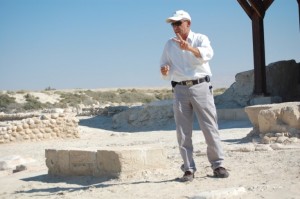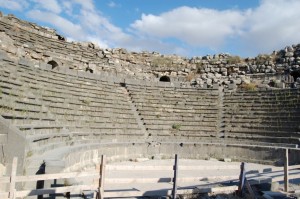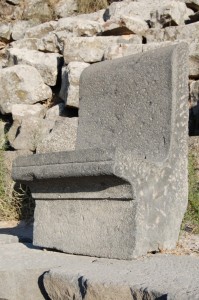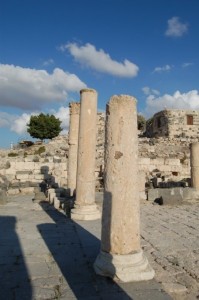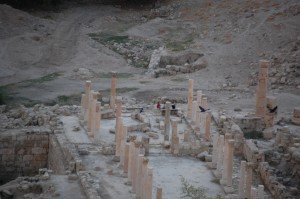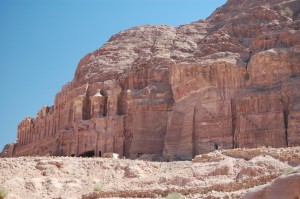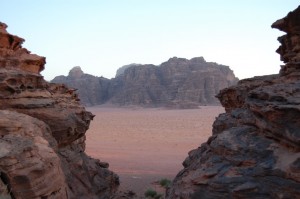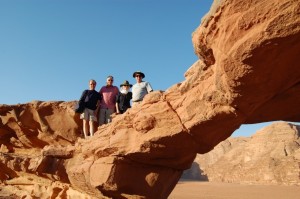The debate over how the first two chapters of Genesis should be interpreted continues to rage within evangelicalism to this day, and will likely continue until Jesus snatches us into His presence and settles the argument. This debate is essentially two centuries old. It appears to have begun around 1814 when Thomas Chalmers proposed a gap in time between Genesis 1:1 and 1:2. He proposed this 45 years before the theory of evolution swept the scientific community, and subsequently the theological community. So, in his case he was not trying to harmonize Scripture with science, but Scripture with Scripture. Today the issue concerns how these first chapters of the Bible should be understood by those who believe it is the word of God. How much should science, ancient Near East (ANE) cosmologies, or literary conventions influence our understanding of the creation account in Genesis 1-2? The approaches to the text vary greatly, as well as the conclusions drawn from it. How can this be? What drives the different positions? And, can we at least understand and appreciate each other as we continue to defend our own views?
In the last century and a half the debate has developed in response to the claims of science as theologians and churchmen have struggled with the question of how to relate the biblical text to the claims of science. To date no consensus has been reached within the Christian community. In just recent months another work has been published encouraging interaction with the various views of creation.[1] Books and articles continue to be published. The interest and controversy has not died down.
It is not the purpose of this paper to delve into the intricacies of each view and develop those arguments for and against them. Rather, the focus is to be on the hermeneutical issues that must be addressed by all if consensus is ever to be reached. Arguments for and against given views will be surveyed rather than developed. They are given solely to enlighten us to each view’s hermeneutics rather than defend or repudiate any given view.[2]
Theories on the Days of Creation
One of the challenges we face is the task of sorting through the various theories. At one time they could be placed into four main groups (Literal Six-day, Day-Age, Literal Days with Ages Between, and Revelatory Days) besides theistic evolution in its several expressions.[3] Today a plethora of views exists and even the traditional ones are nuanced by various proponents. The issue that has developed in recent years principally revolves around the age of the earth. The Literal Six-Day view of Genesis 1-2 falls into the “young earth” model while all others would fit the “old earth” model. This brief survey will attempt to describe some of the present views but not be exhaustive.
Young Earth (24-Hour Day) Theory
The Young Earth Theory sees creation occurring in six consecutive 24-hour periods of time (also known as the Literal 24-Hour Day Theory). The world was created in the order given in the text. The author’s use of “evening and morning” communicates a 24-hour time frame. God created directly and instantaneously. Geological formations can be explained through the Noahic flood.[4]
This view sees itself being consistent with a normal hermeneutic and argues that Genesis1-11 should be read with the same hermeneutic as Gen 12-50.[5] Whenever “day” (yom, יוֹם) is used with a numeral elsewhere in the Old Testament, it normally refers to a 24-hour period and so should be understood that way here.[6] God’s statement to Moses in Exodus 20:11 should be understood literally, and thereby informs the meaning of Genesis 1.[7] Scripture is more authoritative than scientific theory. Genesis 1:1-2:3 should not be seen as poetical in nature, especially when compared to Psalm 104’s description of creation.[8] Rather than seeing Genesis 1-2 reflecting the ANE cosmology, or being a polemic against it, it should be seen as unique revelation reflecting a completely different worldview.[9] The New Testament record affirms the literal interpretation of the creation events.[10] This view does not necessarily hold to a 4004 b.c. date for creation, though it sees the age of the earth between 4,000 and 10,000 years.[11]
Proponents of the Literal 24-Hour Day Theory affirm that there is no gap in time between Genesis 1:1 and 1:2 (No Gap Theory). Two versions of the view have been proposed. First, some proponents speak of “Chaos when Creation.” They see 1:1 as a topic sentence for the whole chapter and not the first day of creation. Verse 2 describes the universe at the point in time that God was in the process of creation (i.e., a part of the creation process involved God creating a formless mass from which He then made the stars and planets, etc.). For them, Genesis 1:1 focuses upon the “fact” of creation. Second, other proponents speak of “Chaos before Creation.” Verse 1 is a general statement which applies to the first day of creation and describes what God created on the first day. Verse 2 tells of the condition of the universe before God began creating with verse 3 continuing to describe God’s process of creation.
Old Earth Theories
Old earth creationists affirm God as creator.[12] However, in contrast to young earth creationists, they see the earth as billions of years old and the universe as even older.[13] For them the findings of geology and astronomy and the Genesis account of creation refer to the same events and so one can affirm the truthfulness of Scripture while accepting the present scientific theories on origins.[14] This view can include theistic evolutionists, but not necessarily. Those holding to an old earth model normally also argue for some version of the Gap Theory and so see the Genesis account describing the re-creation of the earth following its destruction consequent to Satan’s rebellion and fall.
The Gap Theory (Ruin-Reconstruction Theory; Restitution Theory) predated the theory of evolution. Even so, in response to the claims of science, many interpreters of Genesis 1 began to propose that there was an indefinite time gap between 1:1 and 1:2. God created a perfect heaven and earth. Earth was inhabited by a pre-Adamic race of humans ruled over by Satan in the Garden of Eden. Satan rebelled and sin entered the universe (Isa 14). Because of Satan’s rebellion, God punished the earth with a flood and a global ice age (this accounts for the fossils). Many geologists like this theory because it seems to answer questions about fossils.
This view addresses the question of the language of Genesis 1-2. For this view the term “was” (hayah, הָיָה) in verse 2 can be translated “became.” “Formless and void” (tohu wa bohu, תֹ֙הוּ֙ וָבֹ֔הוּ) describes an evil condition, as seen in Isaiah 24:1; 45:18; and Jeremiah 4:23. Two different terms for “create” are used in 1:1 (bara, בָּרָ֣א) and 1:25 (asah, עָשָׂה) and refer to two different types of creation. Bara normally refers to God’s “primary” creative activity (ex-nihilo). Asah always refers to reforming previously existing materials. Since bara is used in 1:1, it cannot be a “topic sentence,” introducing the section which follows (and so being a general description of what follows), but must refer to an original creation. Darkness symbolizes evil in Scripture. God’s command to Adam to “replenish” the earth implies a previous race. Finally, the distance of stars from earth and the amount of time it takes for their light to reach our planet indicates a much older universe and planet. For example, Newman says, “As most of the universe is more than ten thousand light-years away, most of the events revealed by light coming from space would be fictional. Since the Bible tells us that God cannot lie, I prefer to interpret nature so as to avoid having God give us fictitious information.”[15]
The Day-Age Theory (Geologic Day Theory, Progressive Creationism) attempts to correlate the geologic ages with the 7-day period.[16] Each day represents a period of geologic history. The terminology, such as “day,” is metaphorical and so should not be interpreted literally.[17] It seems to take more than 24 hours to accomplish all that is described, especially with regard to Adam’s naming of the animals (1:12). Solar days did not begin until the fourth day and so time could not be measured before then and so at least the first 3 “days” could have been longer than 24 hours. Further, support for this can be seen in the use of “day” in Genesis 2:4 to refer to the entire creation process. Hebrews 4:1-11 is interpreted by this view to also affirm an indefinite period in creation.[18]
The Literal Day with Ages Between Theory (Creative Intervention View) regards each day as a time of completion of creation only (i.e., creation was culminated on that day).[19] “At strategic points in the natural development of the earth the Creator intervened. Thus the days were ordinary days, but between these creative interventions long eons of time may have elapsed.”[20] It has very few adherents. [21]
The Analogical Days Theory (C. John Collins) does not see the Genesis 1 days as the beginning of the universe. Accepting the Gap Theory, he affirms “the six ‘creation days’ are not necessarily the first actual days of the universe; they are not even necessarily the first days of the earth itself. They are the days during which God set up the earth as the ideal place for human being to live…”[22] The first 11 chapters of Genesis should not be taken literally but seen as a “very broad stroke and suggestive rather than detailed” description of the earth’s history before Abraham came on the scene.[23] Genesis 1-2 is “exalted prose” rather than historical narrative and so should be understood “liturgically” rather than literally.[24]
The Literary Day Theory (Richard E. Averbeck) identifies the six days as a literary device used to communicate God’s sovereignty over creation.[25]This literary device, six followed by a seventh pattern, is said to be common to the ANE and with biblical writers as well. Therefore the author of Genesis would not expect his readers to understand the six days as literal, but symbolic.[26] “The ‘days’ here are snapshots of the world as they observed it in that ancient day.”[27] At the same time, the historical reality of Adam and Eve is affirmed. [28] Verse 1 introduces the subject of the following chapter, “not the actual beginning of God’s creation work in the chapter.”[29] Averbeck connects the three-tiered cosmology of the ANE to the biblical account, seeing it (biblical account) using the same pattern, not because it was following ANE cosmologies, but because both the biblical and ANE cosmologies reflect how the world appears to be (phenotype, language of appearance). [30] Further, its purpose is to serve as “an analogy that derives from and reinforces the regular pattern of the work week that God was so concerned the Israelites adhere to: work six days and rest on the seventh… The chapter is schematized, not meant to be read in a literalistic way even by the ancient Israelites, and they would have known that. … Although the seven days are not to be taken literally and are not intended to tell us how long God took in actually creating the cosmos or how old the earth is, nevertheless there is a necessary structure and sequence through the six days.”[31] God could not have given them a scientifically accurate description of creation because they could not understand the science, which continues to be true for us today. He further acknowledges and reminds us all, “There is mystery here for everyone past, present, and future. Whether we look at it biblically or scientifically today, we do not have it all figured out, and we never will.”[32]
The Ancient Cosmology View (John H. Walton) holds that God has “accommodated” His revelation about creation through the use of ANE cosmology to speak to the “cognitive environment” of ancient Israel.[33] Rather than describing creation ex nihilo in Genesis 1:1 or in what follows, the creation account describes God’s reshaping of material from a non-functional state to a “functional” state[34] with a view to building a “temple” in which “divine rest takes place.” [35] This view does not deny creation ex nihilo, but would affirm a gap between that event and the events of Genesis 1:2-2:3. It also does not attempt any correlation with scientific theories since it was not the intention of the author to address issues of science.[36]
Theistic Evolution proponents trust science and “embrace the Darwinian ‘mechanism’ (natural selection) by ‘the eye of faith,’ proclaiming it to be the method instituted by God to achieve creation.”[37] This is “the belief that a theistic God used an evolutionary process he had created to produce all living species of life. In addition, ‘theistic’ means that God performed at least one miracle after his original creation of the universe ex nihilo.” Generally theistic evolutionists will affirm 2 or 3 supernatural interventions of God followed by the remainder of life developing naturally through Darwinian evolution.[38] As a result, Adam need not be a historical person.[39]
The purpose of the Genesis account is to affirm that God was “the creator of everything and everyone. However, the biblical text is not at all interested in telling us how God created the world and humanity, it is perfectly acceptable and even reasonable to turn to the sciences to explore that question.”[40] Figurative language in the Genesis account indicates that it should not be taken literally. Though the author intended the readers to think of literal 24-hour days, “the absence of the sun, moon, and stars until the fourth day means that this pictorial description of creation as taking place during a week is not describing what actually happened.”[41] Longman affirms further that “the Bible is true in what it intends to teach. Genesis 1-2 intends to teach us that God created everything. It intends to teach us much about the nature of God, humanity, and the world, but not about how God created creation, including the sequence of creation.”[42]
Hermeneutical Positions
In this next section we shall address the question of hermeneutics as it may contribute to the debate. One’s hermeneutic has more to do with one’s interpretation than the data of Scripture or science. By understanding each other’s hermeneutic, we can appreciate one another better, though we may not be convinced by the other’s argument. For example, either model (young earth, old earth) can be supported from the Hebrew grammar, or so each side says, though one’s choice seems dependent primarily on how one sees Genesis 1:1 in light of Hebrews 11:3.[43] The same can be said of the various views within the old earth model. Their basic hermeneutical approaches have some measure of validity and usefulness. But are they legitimate determiners of Moses’ intended meaning? We will begin by examining some of the hermeneutical arguments for these views.
Science and Scripture: The first issue to address is the role modern science should play in the interpretation of Scripture.[44] The place of scientific theories and discoveries in the interpretation of Scripture is a hermeneutical issue, not a philosophical one. That science discovers truths about creation is unquestioned by all. The question is whether science has correctly interpreted its data and how much influence its conclusions should have when discerning the meaning of the biblical text.
Hugh Ross is an example of this approach. He says, “God’s revelation is not limited exclusively to the Bible’s words. The facts of nature may be likened to a sixty-seventh book of the Bible. Just as we rightfully expect interpretations of Isaiah to be consistent with those of Mark, so too we can expect interpretations of the facts of nature to be consistent with the message of Genesis and the rest of the canon.”[45]
What has motivated committed Christians with a high view of Scripture to reject a literal interpretation of the text in order to find concordance with scientific theories? It seems two factors have influenced them. In earlier years it was their confidence in science that led to accommodating theories. Since all truth is God’s truth, the truths of science necessarily had to correlate with those of Scripture. In those days there was a high confidence in both science and the sincerity of the scientific community. In recent years, the motive seems to be both that and a desire to gain a hearing from the non-believing community, to make Christianity seem more reasonable and so the gospel more acceptable. Again, Hugh Ross is a good example of this mindset. He says, “Few Christians comprehend just how destructive the age issue has become. The sad irony is that age need not even be an issue. But because it is, numbers of non-Christians turn away from the Christian message.”[46] So, for some, it is an attempt to remove a “stumbling block” that keeps people from accepting the gospel.
Author’s Purpose: A second approach is to determine how literally or figuratively the author intended his work to be understood. The author’s purpose should inform our interpretation of Genesis 1-2. Based on this approach, Tremper Longman III affirmed earlier that it was not the purpose of Genesis 1-2 to tell “us how God created the world and humanity” and this gave him the option of accepting evolution without denying the inspiration of Scripture.[47] If Moses did not intend to communicate an accurate cosmology, but was simply using an allegory or pictorial language, then it is legitimate to interpret it non-literally. The question is not whether the text is inspired or truthful in terms of what it intended to communicate. The question is what it intended to communicate (God created) and how (through a non-literal “pictorial description”).
Ancient Near Eastern Culture: A third approach is to see the passage reflecting the ANE culture from which is arose. This approach is seeking to discern the meaning intended by the author and understood by his audience. It understands that they were people of their day and thought in the categories of their day. Thus what is known of those ANE cultures around them must bear on our understanding of the text.[48] Again, this is not a denial of the inspiration of the text. It is also not a denial that the author’s intended message is true. It is an approach to interpreting Scripture that says its meaning is connected to its world and anything known of that world may be brought to bear in our understanding of the passage.
Literary Genre: All literature is expressed within some understood literary convention which the French called its “genre.” This form, mold, or pattern impacts on how the author intends his words to be understood (how literally, figuratively, seriously, etc). The meaning of a passage is indeed impacted by its genre, though not always determined. The three kinds of literary genre which must be recognized in Scripture include figures of speech, larger figurative units such as parables and allegories, and broad prose categories wherein books may fit such as historical, drama, poetry, apocalyptic, wisdom, didactic, and legal literature, among others. So, what literary genre does Genesis 1-2 represent and how should that affect interpretation? Most old earth proponents identify the first chapters of Genesis as something other than historical narrative, calling it such things as poetry or exalted prose. Young earth proponents argue for historical narrative. If it is poetry or something other than normal prose, then interpreters could legitimately argue against a literal understanding of the affirmations of the text.
Assessment of the Hermeneutical Positions
Having surveyed various views on Genesis 1-2 and identified the hermeneutical approaches leading to these views, it seems appropriate to evaluate these approaches and address their strengths and weaknesses. Again, this cannot be an extensive evaluation or response, but seeks to highlight certain issues and raise questions for further discussion within the body of Christ. Following this evaluation, a proposal will be made that this author feels is the solution to the issue. So, to begin, we should address the question of figurative language within the passage.
Literal versus Figurative Language: Whether one identifies the passage as fitting within historical narrative or some other genre, the presence of figurative language still raises further issues. How literally or figuratively should the language of Genesis 1-2 be understood? And, does the presence of figures of speech necessarily make a passage figurative? There are figures of speech employed in the passage. However, this need not make the assertions of the passage non-literal. In other words, the presence of figurative language in a passage does not necessarily make the passage itself figurative, otherwise what Paul says in Romans should not be taken literally. Further, the principle with figures of speech is that they are literary conventions used by an author to communicate concrete ideas. And, a literal interpretation of a figure involves, then, understanding it is a figure of speech and then discerning its intended meaning. For Moses to say with regard to Adam’s creation that God “breathed into his nostrils the breath of life” (an anthropomorphism) does not require God to place His mouth on Adam’s nose and exhale air into his lungs. It is clearly a figure of speech that indicates that God caused Adam to begin breathing and animated the inanimate body He had just formed out of the soil (dust of the ground) just as He had done with all the animals. When the author of Joshua asserts that at the battle of Gibeon “the sun stood still in the midst of heaven, and did not hasten to go down for about a whole day” (NKJV), his use of “stood still in the midst of heaven” is figurative language, that of appearance. Being figurative, it does not change the historical narrative genre of the passage it was stated in. Theologians, exegetes, and scientists may discuss how God did it and present various theories. However, if any of us had been standing there beside Joshua on that day, we would have seen what he described and said it much the same way since his figurative language spoke in terms of language of appearance and not exact science.
Scripture interprets Scripture: A key hermeneutical principle that would help this debate is that we interpret less clear texts by those whose interpretations are more certain. In biblical interpretation “what is obscure in one passage may be illuminated by another. No single statement or obscure passage of one book can be allowed to set aside a doctrine which is clearly established by many passages.”[49] Thus, “the canon of Scripture is the context of every passage of Scripture. This is the theological version of ‘Scripture interprets Scripture.’ The exegete brings all the other materials that are similar to the text to bear upon the text.” [50] Thus, God’s own words in Exodus 20:11 must bear on our understanding of the text. Similarly, Jesus’ statement should serve as a determiner of the meaning. Jesus uses the Genesis account to support His view on divorce and says, “Have you not read that He who made them at the beginning ‘made them male and female,’ and said, ‘For this reason a man shall leave his father and mother and be joined to his wife, and the two shall become one flesh’?” (Matt 19:4-5). He clearly sees Adam and Eve as historical persons and their creation as historical fact. He is interpreting at least this part of the Genesis account literally and sees the statement as God’s statement, not Moses’. To say He was accommodating His audience by treating what He knew to be figurative language as literal history is to accuse God of deception. This is especially true when we see the pattern exhibited by Jesus is to say what is true regardless of the views of His listeners and regardless of how offended they might be by what He said.[51]
Arguments are advanced on both sides concerning Moses’ use of bara (create) and (form) assah. Granted, John’s use of “become” (ginomai, γίνομαι) John 1:1-3 and the use of “made” (poieō, ποιέω) in Hebrews 1:1-4 are both ambiguous and would allow either creation ex nihilo or from previously formed material. However, in Matthew 19:4 Jesus identifies God as the “Creator” (ho ktisas, ὁ κτίσας) who “made” (poieō, ποιέω) them. The verb, “create” (ktizō, κτίζω) and noun, “Creator” are used only of God throughout the New Testament and reflect the sense of creation ex nihilo and not the reshaping of material.[52] “Made” (poieō) is connected with “create” (ktizō) as a synonym and so its use in the New Testament may rightly be understood as original creation and not reshaping of previously created matter. Paul’s view of creation is clarified by his statement in Romans 4:17 that “those things which do not exist” were called into existence by God, thus creation ex nihilo.
As Beale notes, “At least twenty-five NT passages refer to Gen 1-11, and all take the accounts literally.”[53] It would seem that our interpretation of Genesis 1-2 should be based on this pattern of New Testament teaching, by both Jesus and the inspired authors.
The place of science with respect to the interpretation of Scripture: Hugh Ross is correct in stating that God has revealed Himself in the created universe and all men are held accountable for what they learn through general revelation (Rom 1:20). However, the natural response of fallen man is to reject those truths rather than respond to God’s revelation (Rom 1:21-23). As a result, we can know that science is capable of finding facts about creation, but should not expect the unbelieving scientific community to interpret those facts in a manner that acknowledges or glorifies the God whose existence they deny.[54] Science is not omniscient. Science is not unbiased. Modern secular, naturalist scientists, in their rejection of God, will naturally suppress the truth (Rom 1). They may be able to find the data, but may not always be able to interpret it correctly.[55] This would explain why biologists, who understand the principle of irreducible complexity, refuse to abandon the dogma that organic life arose from an inorganic soup. Even the simplest viruses are far too complex for one to form, even over billions of years.[56] Granted, there are scientists who are sincerely attempting to interpret the data honestly. However, that does not guarantee they will not be influenced in the assessment by the dominant theories of the day and the preponderance of literature supporting one view over the other. That being said, those holding to a literal six-day creation should also be circumspect about using scientific data to support their view. Its best role is illustrative, not interpretive.
A further question must be asked. Why should we limit God to what science says is possible or reasonable? When God acts, His will shapes history and the natural order. Why not accept that God can create things in whatever order He desires and nature will accede to His will? Since God is not limited by time, why should the amount that He can accomplish in any 12 or 24 hour time period be determined by our human limitations? Moses lived 40 days on Mount Sinai without food or water because God wanted to meet with him there. Why couldn’t Adam name every creature in an hour or two if it were God’s will for him to accomplish that task on the sixth day? God is not bound by any of the “laws of nature” that science has discovered or decided on (may yet disprove or revise them with future discoveries). Nature obeys Him, not He nature.
Authorial Intent’s Place in the Interpretive Process: Interpreting a passage on the basis of an unstated author’s intention does not necessarily lead to legitimate results. If we misunderstand or misstate the author’s purpose, and use that mistaken purpose as our interpretive guide, we will end up with eisegesis rather than exegesis. Norman L. Geisler provides an excellent discussion of this issue. [57] He summarizes his points as follows.
1. Purpose is not hermeneutically determinative of meaning. Why something is said never determines the meaning of what is said.
2. Purpose is formally independent of meaning. One can understand what is meant, even if he does not understand why it was said.
3. Using purpose to determine meaning leads to a distortion of the true meaning by reshaping the meaning to fit the purpose.
4. Using purpose to determine meaning confuses application (why) with interpretation (what). It confuses the content of the message with the behavioral change in the lives of the readers envisioned by the author.
5. Using purpose to determine meaning is a hermeneutical form of “the end (purpose) justifies (validates) the means (meaning)” principle. It is hermeneutical utilitarianism.
This is not to deny that understanding purpose is often interesting and even illuminating. For how a passage is applied or why an author wrote it (that is, what changes he purposed in the readers) can be helpful in understanding the significance of the passage. However, to limit the application of the passage to our conjectures about the author’s purpose, or to eliminate certain aspects of truth in the passage because they are not believed to be necessary to the central purpose, is hermeneutically illegitimate. It in fact may lead to a denial of the full inspiration and inerrancy of Scripture, as well as other teachings.[58]
In that light, Longman’s commitment to the truth of God’s word should never be questioned. However, his hermeneutical approach to this passage may.
The Place of Extra-biblical Data in the Interpretive Process: What should be the role of ANE and extrabiblical data in determining the meaning of the text? William Larkin provides an excellent guide. “Though extra biblical cultural information may be used to illumine meaning, it must never be employed to limit or undercut the authoritative claims of Scripture.”[59] The problem with using extra-biblical data to give meaning to the biblical text is similar to using scientific data. Our knowledge is incomplete. Further, we cannot demonstrate conclusively that the author had that piece of data in mind when he wrote. For example, most arguments for reading ANE cosmology into the Genesis account attempt to point to parallels with their creation myths.[60] Gordon Wenham notes that “we often fail to recognize the striking originality of the message of Gen 1–11 and concentrate on subsidiary points that may well be of less moment.”[61]Additionally, to say that the Genesis account is a polemic against any or all of these is speculative.[62] Moses does not say such in Genesis, nor does the evidence of the text require such a thing. Rather, there are so few connections with ancient cosmologies, it seems better to see him ignoring them all as he communicates God’s revelation of how He did it. Rather than seeing Genesis 1-2 as a corrective, we should see it as a positive foundational statement that describes the beginning of creation as concretely as Revelation 21-22 describes its culmination.
Genre’s Role in Biblical Interpretation: The use of genre as an interpretive guide has proven useful. However, its usefulness lies within the limits of what it can contribute. Genre does not determine meaning. Genre guides the interpreter to search for certain kinds of textual clues to the meaning intended by the author. No genre is mono-faceted. Each has a set of rules or principle by which it functions, and so is to be interpreted. However, when using genre as a guide, it is imperative that an interpreter can demonstrate that his or her choice of genre is legitimate. That is the problem in this passage. The weight of evidence, especially its structure, grammar, and connection with the remainder of Genesis through the author’s use of toledoth, argues for it being the same genre as the rest of Genesis, historical narrative.[63] However, even if one were to demonstrate it is not of the same genre as the rest of Genesis, it need not lead to a denial of the historicity of its affirmations.[64] Factual statements can be made through the figurative language of poetry just as factual statements are made through prose. Proper hermeneutics finds the facts behind the figures in poetic literature as much as they should in prose. And, in the case of Genesis 1-2, since the New Testament authors understood its affirmations in a literal manner, it seems best to accept them as literal and not beg the question with an appeal to some special genre.
The Revelatory Nature of Biblical Assertions
It seems that the real issue behind this debate is the role that Scripture plays in the communication of God’s truth. The church needs to view Scripture as revelatory. It is God’s revelation of reality, including not just His will (faith and practice), but His work as well (science and history). If He inspired the authors of Scripture to write it, He meant it to be understood. Granted, He used their personalities, spoke to their cultures and times, used various genres of literature to communicate through, and filled His revelation with mysteries we will not discover till we are in heaven. However, when we find something in Scripture that seems to contradict what our scientists, historians, archaeologists, or any other discipline, think is true, we should trust God to know what He is talking about. God is the God of all truth and does not lie. As the Holy Spirit superintended the writing of Scripture, He insured its authors wrote truth. So what if what they say proves to be a stumbling block to some (or foolishness)? Like Paul in Athens, we don’t back down from the truth of God’s revelation even when we know that some will scoff. If we see the Scriptures as revelatory truth from our God, we should trust and obey it, not adjust its meaning to accommodate either our own views or those of a lost and dying world.
Concluding Thoughts
My hope is that what I have written may be seen in its irenic sense. I do not question the salvation or commitment of anyone holding to any of these views. All of us serve the same risen Savior. All of us will spend an eternity in heaven together, worshipping the God who created this universe and continues to amaze us with its grandeur. That being said, a statement that I found troubling comes from Tremper Longman III in his response to Todd Beal: “While his view is widely held by many laypeople, for some reason the scholars who argue for this view rarely interact with those of us who hold a different viewpoint, and often when they do, the conversation becomes acrid.”[65] First, the invocation of “many laypeople” does not invalidate a scholar’s view. This is a pejorative statement that evidences a low opinion of the vast majority of the body of Christ when attempting to denigrate one particular view.
Let us debate our differences, but in a manner that respects each other, especially in matters that do not affect one’s salvation or standing with God. We need perspective. Jesus said the world will know us by our love for one another (John 13:35), and that involves how we speak to each other when we disagree as much as when we agree. I am a six-day creationist. With any brother or sister who holds any of these other views, I will gladly stand with them and die for Jesus if that day ever comes.
A final note. Do you know what the favorite game will be in heaven among theologians? Hide and Seek. Those who turned out to be wrong will be hiding from those who turned out to be right. And when they finally meet, the winner will say, “I told you so. Now, brother, let’s go get some manna.”
[1] The most recent is Reading Genesis 1-2: An Evangelical Conversation (Peabody, MA: Hendrickson Publishers, 2013), edited by J. Daryl Charles and interacting with the views of Richard E. Averbeck (Literary Days), Todd S. Beall (Literal Days), C. John Collins (Analogical Days), Tremper Longman III (Theistic Evolution), and John H. Walton (Ancient Cosmology).
[2] Because there are so many views, it is difficult to keep this first section brief and do the various views justice. That being said, this writer acknowledges that he is a six-day young earth creationist and practices a literal hermeneutic. At the same time, he respects those who hold differing views and recognizes that they have arrived at their views thoughtfully. Though we may disagree, we remain brothers and sisters in Christ who serve the same risen Savior.
[3] Gerald Rau (Mapping the Origins Debate: Six Models of the Beginning of Everything (Downers Grove, Ill: IVP Academic, 2012) compares and contrasts six “models of origins” which include what he calls Naturalistic Evolution, Nonteleological Evolution, Planned Evolution, Directed Evolution, Old-Earth Creation, and Young-Earth Creation.
[4] Paul P. Enns, The Moody Handbook of Theology (Chicago, IL: Moody Press, 1989), 303
[5] Todd S. Beall, “Reading Genesis 1-2: A Literal Approach,” in Reading Genesis 1-2: An Evangelical Conversation, J. Daryl Charles ed. (Peabody, MA: Hendrickson Publishers, 2013) 46-48. He argues (47), “In addition to the genealogies, there are two other structural indicators that Gen 1-11 is to be understood in a similar way to Gen 12-50. First, Gen 12:1 starts with a waw-consecutive verb, wayyomer (‘and he said’), indicating that what follows is a continuation of Gen 11, not a major break in the narrative. Second, the structure of the entire book is based on the phrase ’lelh toledoth (‘these are the generations of’ or ‘this is the history of’) that occurs ten times in Genesis.”
[6] Robert V. McCabe (“A Defense of Literal Days In the Creation Week,” Detroit Baptist Seminary Journal 5 (2000): 100-112) provides an excellent discussion of the significance of yom (יוֹם) in Genesis 1, as well as Jim Stambaugh (“The Days of Creation: A Semantic Approach,” Journal of Ministry and Theology, 7:2 (2003) 41-68; and “The Days of Creation: A Semantic Approach, Part II,” Journal of Ministry and Theology, 8:1 (2004) 37-54).
[7] “For in six days the Lord made the heavens and the earth, the sea and all that is in them, and rested on the seventh day; therefore the Lord blessed the Sabbath day and made it holy.” (NKJV)
[8] Todd S. Beall, “Reading Genesis 1-2: A Literal Approach,” in Reading Genesis 1-2: An Evangelical Conversation, J. Daryl Charles ed. (Peabody, MA: Hendrickson Publishers, 2013) 48.
[9] Todd S. Beall, “Reading Genesis 1-2: A Literal Approach,” in Reading Genesis 1-2: An Evangelical Conversation, J. Daryl Charles ed. (Peabody, MA: Hendrickson Publishers, 2013) 51. “To argue that Moses or whoever wrote Gen 1-11 was so immersed in the ANE world that it caused him to write in the way of other ANE literature is to deny the uniqueness of the biblical record.” He says further (52) that “…the biblical account in Genesis is so unlike other ANE literature that many scholars hold that the creation account is a polemic against the ANE creation myths. If the perspective of Gen 1-11 is so contrary to the ANE worldview, then why should one assume that it was written according to that same worldview? It stands apart from the ANE worldview in every respect, beginning with the most obvious difference: there is only one God, not many, he is eternal, not a created; and he created the rest of the world in an orderly, purposeful way.”
[10] Todd S. Beall, “Reading Genesis 1-2: A Literal Approach,” in Reading Genesis 1-2: An Evangelical Conversation, J. Daryl Charles ed. (Peabody, MA: Hendrickson Publishers, 2013) 53. He notes that 25 references to creation in the NT all interpret the Genesis account literally and historically. Examples include Jesus in Matt 19:4-6 and Paul in Eph 5:31; 1 Cor 6:16; 11:7-12.
[11] Gary C. Cohen, “Hermeneutical Principles and Creation Theories,” Grace Journal 5:3 (1964): 26. He says, “It should be noted here that the dating of Archbishop Ussher (1581–1656) which placed the beginning of creation in the year 4004 B.C. is not an inherent part of this theory. In fact, the 4004 B.C. date has now generally been abandoned.”
[12] Representative of this movement are C. John Collins (“Reading Genesis 1-2: Analogical Days,” in Reading Genesis 1-2: An Evangelical Conversation; Robert C. Newman and Herman J. Eckelmann, Jr. in their book Genesis One and the Origin of the Earth (Downers Grove, IL: InterVarsity Press, 1977; reprint, Grand Rapids: Baker Book House, 1981), Daniel E. Wonderly in God’s Time-Records in Ancient Sediments: Evidences of Long Time Spans in Earth’s History (Flint, MI: Crystal Press, 1977) and Davis A. Young in Creation and the Flood: An Alternative to Flood Geology and Theistic Evolution (Grand Rapids: Baker Book House, 1977), Christianity and the Age of the Earth (Grand Rapids: Zondervan Publishing House, 1982) and The Bible, Rocks and Time: Geological Evidence for the Age of the Earth (Downers Grove, Ill: IVP Academic, 2008). Early proponents include G. H. Pember, (The Earliest Ages) the Scholfield reference Bible, and Arthur Custance (Without Form and Void). This view is not recent, though. It was held by Augustine (Augustine, Confessions, 12:8).
[13] Robert C. Newman, “Progressive Creationism” in Three Views on Creation and Evolution, ed. J. P. Moreland and John Mark Reynolds (Grand Rapids: Zondervan, 1999) 105.
[14] For example, Robert C. Newman (“Progressive Creationism” in Three Views on Creation and Evolution, ed. J. P. Moreland and John Mark Reynolds (Grand Rapids: Zondervan, 1999) 119) affirms that “the data of Scripture and the data of nature are fully trustworthy, and that some sort of harmonization exists between the proper interpretation of each.”
[15] Robert C. Newman, “Progressive Creationism” in Three Views on Creation and Evolution, ed. J. P. Moreland and John Mark Reynolds (Grand Rapids: Zondervan, 1999) 109.
[16] Examples of proponents include: Hugh Ross (Creation and Time: A Biblical and Scientific Perspective on the Creation-Date Controversy (Colorado Springs, CO: NavPress, 1994), and The Genesis Question: Scientific Advances and the Accuracy of Genesis (Colorado Springs, CO: NavPress, 1998)), Robert Newman (Genesis One and the Origin of the Earth (Hatfield, PA: Interdisciplinary Biblical Research Institute, 1989).
[17] Paul P. Enns, The Moody Handbook of Theology (Chicago, IL: Moody Press, 1989), 302.
[18] David G. Hansen, “יוֹם YOM: A Study of the Hebrew Word Yom in the Creation Narrative (Genesis 1, 2),” Bible and Spade (1998) 11 (1998): 39.
[19] P. J. Wiseman, Creation Revealed in Six Days (1949); Robert C. Newman is identified as an advocate by James E. Smith (The Pentateuch).
[20] James E. Smith, The Pentateuch, 2nd ed., Old Testament Survey Series (Joplin, MO: College Press Pub. Co., 1993).
[21] Likewise, the Revelatory Day Theory (Pictoral Day Theory) has passed from serious consideration in recent years. It is mentioned or proposed by, among others, A. H. Strong (Systematic Theology (Philadelphia: Judson Press, 1956), Vol. II, pp. 393–397); H. Kurtz, Bible and Astronomy (third German edition, 1857); P. J. Wiseman, Creation Revealed in Six Days (1949); E. K. Gedney, “Geology and the Bible,” The American Scientific Affiliation, Modern Science and Christian Faith (Wheaton, IL: Van Kampen Press, 1950), pp. 23-57; Bernard Ramm, The Christian View of Science and Scripture (Grand Rapids: Eerdmans Publishing Co., 1954.
[22] C. John Collins, “Reading Genesis 1-2: Analogical Days,” in Reading Genesis 1-2: An Evangelical Conversation, J. Daryl Charles ed. (Peabody, MA: Hendrickson Publishers, 2013) 85.
[23] C. John Collins, “Reading Genesis 1-2: Analogical Days,” in Reading Genesis 1-2: An Evangelical Conversation, J. Daryl Charles ed. (Peabody, MA: Hendrickson Publishers, 2013) 85.
[24] C. John Collins, “Reading Genesis 1-2: Analogical Days,” in Reading Genesis 1-2: An Evangelical Conversation, J. Daryl Charles ed. (Peabody, MA: Hendrickson Publishers, 2013) 86. He says that what makes it exalted prose are “the quasi-liturgical recounting of God’s achievements in creation; the highly patterned presentation of the days, beginning with ‘and God said’ and ending with evening followed by morning; the lack of ‘normal’ names for the things mentioned, together with the rhetorically high ‘expanse’ and allusive reference to the sun and moon; the very broad taxonomies for plants and animals—combine with the unique events, and with God’s own appreciation for his work and his ‘rest’ on his Sabbath, to give the narrative a high and exalted feel, something we do not encounter in other narrative passages in the Bible.”
[25] K. A. Mathews (Genesis 1-11:26, vol. 1A, The New American Commentary (Nashville: Broadman & Holman Publishers, 1996), 110) could fit into this category. He sees the chapter arranged topically rather than chronologically. Also this is similar to the Framework Theory described by Robert V. McCabe (“A Critique of the Framework Interpretation of the Creation Account,” Detroit Baptist Seminary Journal 11 (2006): 61). “In essence, the framework interpretation argues that the creation ‘week’ itself is a figure, a literary framework, designed to present God’s creative work in a topical, nonsequential manner, as opposed to a literal week comprised of sequential, literal days. As noted in the previous article, the framework interpretation is supported by four theses: the figurative nature of the creation account, the creation account controlled by ordinary providence, the unending nature of the seventh day, and the two-register cosmology.” Meredith G. Kline “Because It Had Not Rained,” Westminster Theological Journal 20 (May 1958): 145–57. Others who follow Kline include: Henri Blocher, In the Beginning, trans. David G. Preston (Downers Grove, IL: InterVarsity Press, 1984), pp. 53, 56; Mark D. Futato, “Because It Had Rained: A Study of Gen 2:5–7 with Implications for Gen 2:4–25 and Gen 1:1–2:3, ” Westminster Theological Journal 60 (Spring 1998): 2–10, 13–17; Mark Ross, “The Framework Hypothesis: An Interpretation of Genesis 1:1–2:3, ” in Did God Create in Six Days? ed. Joseph A. Pipa, Jr., and David W. Hall (Taylors, SC: Southern Presbyterian Press, 1999), pp. 122–28; Lee Irons with Meredith G. Kline, “The Framework View,” in The Genesis Debate: Three Views on the Days of Creation, ed. David G. Hagopian (Mission Viejo, CA: Crux Press, 2001), p. 230; W. Robert Godfrey, God’s Pattern for Creation (Phillipsburg, NJ: Presbyterian & Reformed, 2003), pp. 52–53.
[26] Richard E. Averbeck, “A Literary Day, Inter-Textual, and Contextual Reading of Genesis 1-2,” in Reading Genesis 1-2: An Evangelical Conversation, J. Daryl Charles ed. (Peabody, MA: Hendrickson Publishers, 2013) 7.
[27] Richard E. Averbeck, “A Literary Day, Inter-Textual, and Contextual Reading of Genesis 1-2,” in Reading Genesis 1-2: An Evangelical Conversation, J. Daryl Charles ed. (Peabody, MA: Hendrickson Publishers, 2013) 8. He balances what he says by noting (Reading Genesis 1-2, 9): “Unfortunately, since the beginning of the twentieth century there has been a long history of scholars illegitimately imposing ANE material on the biblical text. … Scholars, including evangelical scholars, disagree over the sort of relationship Genesis and extrabiblical sources have to each other. Yes, God spoke his revelation into this ANE context, but he also spoke against it.” In response to those who attempt to connect Psalm 104 and Gen 1, he acknowledges that neither borrowed from the other, just that “they reflect the same underlying observational reality. … Psalm 104 follows a pattern that corresponds closely to that of the six days in Gen 1, but without the rigid divisions between the days” (Reading Genesis 1-2, 17).
[28] Richard E. Averbeck, “A Literary Day, Inter-Textual, and Contextual Reading of Genesis 1-2,” in Reading Genesis 1-2: An Evangelical Conversation, J. Daryl Charles ed. (Peabody, MA: Hendrickson Publishers, 2013) 8.
[29] Richard E. Averbeck, “A Literary Day, Inter-Textual, and Contextual Reading of Genesis 1-2,” in Reading Genesis 1-2: An Evangelical Conversation, J. Daryl Charles ed. (Peabody, MA: Hendrickson Publishers, 2013) 10.
[30] Richard E. Averbeck, “A Literary Day, Inter-Textual, and Contextual Reading of Genesis 1-2,” in Reading Genesis 1-2: An Evangelical Conversation, J. Daryl Charles ed. (Peabody, MA: Hendrickson Publishers, 2013) 12-17.
[31] Richard E. Averbeck, “A Literary Day, Inter-Textual, and Contextual Reading of Genesis 1-2,” in Reading Genesis 1-2: An Evangelical Conversation, J. Daryl Charles ed. (Peabody, MA: Hendrickson Publishers, 2013) 31.
[32] Richard E. Averbeck, “A Literary Day, Inter-Textual, and Contextual Reading of Genesis 1-2,” in Reading Genesis 1-2: An Evangelical Conversation, J. Daryl Charles ed. (Peabody, MA: Hendrickson Publishers, 2013) 32.
[33] John H. Walton, “Reading Genesis 1 as Ancient Cosmology,” in Reading Genesis 1-2: An Evangelical Conversation, J. Daryl Charles ed. (Peabody, MA: Hendrickson Publishers, 2013) 143.
[34] John H. Walton, “Reading Genesis 1 as Ancient Cosmology,” in Reading Genesis 1-2: An Evangelical Conversation, J. Daryl Charles ed. (Peabody, MA: Hendrickson Publishers, 2013) 147.
[35] John H. Walton, “Reading Genesis 1 as Ancient Cosmology,” in Reading Genesis 1-2: An Evangelical Conversation, J. Daryl Charles ed. (Peabody, MA: Hendrickson Publishers, 2013) 158.
[36] John H. Walton, “Reading Genesis 1 as Ancient Cosmology,” in Reading Genesis 1-2: An Evangelical Conversation, J. Daryl Charles ed. (Peabody, MA: Hendrickson Publishers, 2013) 162. For example, he says, “The hermeneutical commitment to read the text at face value elevates this interpretation, because it makes an attempt to understand the text as the author and audience would have understood it. It does not reduce the text to a symbolic, figurative, theological, or literary reading, as is often done in the attempt to correlate the text to modern science. As an account of functional origins of the cosmos as a temple, it has no correlation with the material interests of modern science and does not offer a biblical view of material questions. Concordism applies scientific meanings to words and phrases in the text that are modern in ways.”
[37] David H. Lane, “Theological Problems with Theistic Evolution,” Bibliotheca Sacra 151, no. 602 (1994): 156. Other representatives of this view include A. H. Strong (Systematic Theology (Philadelphia: American Baptist Publication Society, 1907), 465-66), and Tremper Longman III. J. Barton Payne (“Theistic Evolution and the Hebrew of Genesis 1–2,” Journal of the Evangelical Theological Society 8:2 (1965): 75-89) provides an excellent response to their arguments from the terminology of the text.
[38] Norman L. Geisler, Baker Encyclopedia of Christian Apologetics, Baker Reference Library (Grand Rapids, MI: Baker Books, 1999), 233. This is opposed to deistic evolutionists who see God only creating the matter from which life eventually evolved on its own.
[39] Tremper Longman III, “What Genesis 1-2 Teaches (and What It Doesn’t),” in Reading Genesis 1-2: An Evangelical Conversation, J. Daryl Charles ed. (Peabody, MA: Hendrickson Publishers, 2013) 122. “My understanding of Gen 1-2 as high style literary prose narrative leads me to conclude that it is not necessary that Adam be a historical individual for this text to be without error in what it intends to teach.”
[40] Tremper Longman III, “What Genesis 1-2 Teaches (and What It Doesn’t),” in Reading Genesis 1-2: An Evangelical Conversation, J. Daryl Charles ed. (Peabody, MA: Hendrickson Publishers, 2013) 103.
[41] Tremper Longman III, “What Genesis 1-2 Teaches (and What It Doesn’t),” in Reading Genesis 1-2: An Evangelical Conversation, J. Daryl Charles ed. (Peabody, MA: Hendrickson Publishers, 2013) 105.
[42] Tremper Longman III, “What Genesis 1-2 Teaches (and What It Doesn’t),” in Reading Genesis 1-2: An Evangelical Conversation, J. Daryl Charles ed. (Peabody, MA: Hendrickson Publishers, 2013) 108.
[43] “By faith we understand that the worlds were framed by the word of God, so that the things which are seen were not made of things which are visible.” (NKJV)
[44] Though the question of the language of appearance will not be discussed at length in this paper Gary C. Cohen (“Hermeneutical Principles and Creation Theories,” Grace Journal 5:3 (1964): 19) provides a helpful reminder that phenomenological language must be recognized. “Interpreters must remember that the Bible describes natural phenomena geocentrically, anthropocentrically, and in the language of appearance.”
[45] Hugh Ross, Creation and Time (Colorado Springs, CO: NavPress, 1994) 56-57.
[46] Hugh Ross, Creation and Time (Colorado Springs, CO: NavPress, 1994) 10.
[47] Tremper Longman III, “What Genesis 1-2 Teaches (and What It Doesn’t),” in Reading Genesis 1-2: An Evangelical Conversation, J. Daryl Charles ed. (Peabody, MA: Hendrickson Publishers, 2013) 103.
[48] Victor Harold Matthews, Mark W. Chavalas, and John H. Walton, The IVP Bible Background Commentary: Old Testament, electronic ed. (Downers Grove, IL: InterVarsity Press, 2000). “The background material most helpful for understanding the first section is the mythological literature of the ancient Near East. Both Mesopotamian and Egyptian mythology provide a wealth of materials concerning contemporary perspectives on the creation of the world and of human beings.”
[49] Milton S. Terry, Biblical Hermeneutics (Reprint. Grand Rapids: Zondervan, 1974) 579.
[50] Bernard L. Ramm, “Biblical Interpretation,” ed. Ralph G. Turnbull, Baker’s Dictionary of Practical Theology (Grand Rapids, MI: Baker Book House, 1967), 107. Gary C. Cohen (“Hermeneutical Principles and Creation Theories,” Grace Journal 5:3 (1964): 19) says well, “No interpretation is really complete until it has considered parallel passages and related references. … Two sub-principles further guide the rule that Scripture interprets Scripture. They are: (a) the clear governs the obscure; and (b) the specific governs the general.”
[51] For example, Jesus does not hesitate to reject the Samaritan woman’s worship as illegitimate in John 4:22. He said the opposite of what any Samaritan would wish to hear. He was just as blunt with the Jewish leaders (Matt 9:1-7; John 5:17-18; 10:30).
[52] Werner Foerster, “κτίζω, κτίσις,” TDNT, 1025-1029.
[53] Todd S. Beall, “Reading Genesis 1-2: A Literal Approach,” in Reading Genesis 1-2: An Evangelical Conversation, J. Daryl Charles ed. (Peabody, MA: Hendrickson Publishers, 2013) 53. Also, Russell T. Fuller, “Interpreting Genesis 1-11,” Southern Baptist Journal of Theology Volume 5” 5: 3 (2001): 19. Bob Goette (“Why Talk About Creation?” Bible and Spade 3:2 (1990): 46) affirms, “There are 200 quotations or allusions in the New Testament to Genesis, and 107 of these are to the first eleven chapters of Genesis. Sixty-three of the allusions are to the first three chapters of Genesis and 25 of those are from Christ himself.”
[54] I am speaking as one who has trained in the sciences and conducted scientific research (B.S. and M.S. degrees in Horticulture, a division of plant sciences) as well as being trained in biblical exegesis and theology. Todd Beal correctly observes (“Reading Genesis 1-2: A Literal Approach,” 56) that “many scholars propose nonliteral interpretations of Gen 1-2 in order to harmonize the biblical text with current scientific theory. They have little to do with the exegesis of Gen 1, since the simplest, most direct reading of the text indicates that God created the world in six twenty-four-hour days, as many of the same evangelical scholars acknowledge.”
[55] Noel Weeks, “The Hermeneutical Problem of Genesis,” Themelios: Volume 4, No. 1, January/September 1978 (1978): 14. He warns, “In order to conclude that a scientific theory is a correct interpretation of general revelation one must be certain that the method by which it was established was not in any way contrary to biblical teaching.”
[56] Michael Behe (Darwin’s Black Box: The Biochemical Challenge to Evolution (New York: Free Press, 1996)) provides an excellent discussion of this problem.
[57] Norman L. Geisler, “The Relation of Purpose and Meaning in Interpreting Scripture,” Grace Theological Journal 5 (1984): 229-45.
[59] William J. Larkin, Jr., Culture and Biblical Hermeneutics (Grand Rapids, MI: Baker Book House, 1988), 261.
[60] K. A. Mathews (Genesis 1-11:26, vol. 1A, The New American Commentary (Nashville: Broadman & Holman Publishers, 1996), 90–95) provides an excellent discussion of the points of similarity and difference between the various cultures surrounding Israel at the time of the Exodus, including Mesopotamia, Egypt, and Canaan.
[61] Gordon J. Wenham, Genesis 1–15, vol. 1, Word Biblical Commentary (Dallas: Word, Incorporated, 1998), l.
[62] K. A. Mathews, Genesis 1-11:26, vol. 1A, The New American Commentary (Nashville: Broadman & Holman Publishers, 1996), 119–120. “The author was not a mimic who historicized a pagan version in order to satisfy a developed Yahwism. Although it is too strong to claim that the biblical account is a direct polemic, it is clear that the author had no use for pagan ideology and carefully distinguished biblical cosmology from pagan misconceptions. The author chose the conventional language of his times, but he was not a conventional thinker.”
[63] K. A. Mathews, Genesis 1-11:26, vol. 1A, The New American Commentary (Nashville: Broadman & Holman Publishers, 1996), 114.
[64] K. A. Mathews (Genesis 1-11:26, vol. 1A, The New American Commentary (Nashville: Broadman & Holman Publishers, 1996), 111) notes that the passage “claims historicity” and so should be interpreted that way regardless of its literary design.
[65] Tremper Longman III, “Four Responses to Chapter Two,” in Reading Genesis 1-2: An Evangelical Conversation, J. Daryl Charles ed. (Peabody, MA: Hendrickson Publishers, 2013) 65.
 For forty-two years, they have camped around the world. The exploits of Gary and Monika Westcott have been captured on their Turtle Expedition blog. For someone who grew up loving to go camping, I think this may be one of the greatest jobs ever. Companies pay them to test their products, by going camping.
For forty-two years, they have camped around the world. The exploits of Gary and Monika Westcott have been captured on their Turtle Expedition blog. For someone who grew up loving to go camping, I think this may be one of the greatest jobs ever. Companies pay them to test their products, by going camping.
